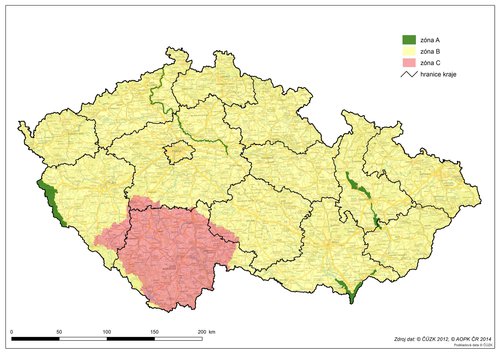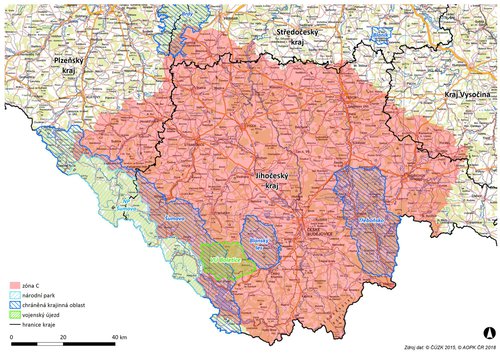Management Plan – Eurasian Beaver
Castor fiber
The aim of the Management Plan is to ensure the existence of a viable population of the Eurasian Beaver in the territory of our country and at the same time to reduce the socioeconomic impact of the occurrence of this species. Management Plan for the Eurasian Beaver in the Czech Republic is a set of conservation, management, legislative and popularization measures. The time horizon for its effectiveness is 10 – 15 years. Individual measures will be reviewed during its course and will be revised if they do not contribute to reaching the set objectives.
The concept of the Management Plan is based on so-called zoning of differentiated protection. This zoning lies in defining three zones (A, B, C) in the territory of our country (see picture below). The degree of interest given on one hand to the protection of beavers and on the other hand to the concentration of risk when it comes to serious damage, is distinguished in the three zones. Long-term existence of beavers in the Czech Republic should be ensured primarily based on protecting populations in areas of zone A, that is a countrywide network of areas that are able to support a viable population not dependent on immigration. Zone A consists mainly of Sites of Community Importance where the Eurasian Beaver is a subject of protection. Zone B includes areas which are not primarily designated for development and protection of beaver populations. The management of beaver populations in these areas will be carried out in such a way that beaver activities do not become the main cause of stopping human use of the landscape. However, zone B must at the same time allow migration links for areas of zone A. Following a detailed analysis of the territory of the Czech Republic, a large area – zone C – has been defined, where the population of Eurasian Beaver will be actively eliminated with regard to the risk of damage of national importance.
Zone C delineation was based on the frequency of the most significant risk factor, which is the presence of water structures vulnerable to beaver activities, especially ponds and water reservoirs. In particular, historical objects without sufficiently fortified dams and with the occurrence of large areas of habitats with high productivity for beaver populations are at risk. The area of South Bohemian pond systems (Třeboňská, Českobudějovicko-hlubocká, Vodňanská, Lnářsko-blatenská) has been assessed as the one most at risk. This area contains more than 3 000 ponds and water reservoirs with a total surface area of almost 20 000 ha, and a large part of them are historical constructions with insufficient resistance to disturbances by Eurasian Beaver activities. Beaver activity (i.e. burrowing shelter or settlement burrows) in their dams may impair their functionality. Besides ponds and water reservoirs, beaver activity could also threaten the functionality and safety of the intricate network of canals and tributaries that feed the ponds. In the Třeboň region, Zlatá stoka (Golden Sewer) and Nová řeka (New River) belong to the most well-known historical works. The Nová řeka with a length of 13.5 km feeds for example the ponds Ženich and Vdovec. The Zlatá stoka is approximately 45 km long and feeds for example the ponds Svět and Dvořiště. Most threatened are the parts of feeder channels or raceways that run above ground level (disturbance of banks by burrowing with the risk of breaching). However, in case of developing a strong population, even the construction of beaver dams and disturbance of water distribution within the pond systems would not be a negligible issue.
In order to effectively prevent the occurrence of serious damage in this area, and thus also to stop overall deterioration of social acceptability of the species in the Czech Republic, it is most suitable to ensure the elimination of permanent beaver colonization in the entire area concerned. Since beavers are able to migrate along streams as far as 80 km in one week, it was appropriate to define the boundaries of zone C by using natural migration barriers. These are represented by watersheds of streams flowing through the South Bohemian pond areas with a final profile to the Orlík dam. These streams are mainly the rivers Lužnice, Nežárka, Malše, Otava, Blanice and part of the Vltava. With regard to the mission and objectives of the National Park, the area of NP Šumava is not included in zone C.
Within the Management Plan implementation, legislative-administrative measures are planned to ensure the implementation of the zoning of differentiated beaver protection concept in the Czech Republic. An analysis of the status and possibilities of solving the economic damage caused by beavers will be prepared as part of fulfilling the goals of the Management Plan. Compensation for part of such damage can be claimed in accordance with Act No. 115/2000 Coll., as amended, on Compensation of Damages Caused by Selected Specially Protected Fauna Species. Damage resulting from restrictions caused by the activities of a specially protected animal may be claimed in accordance with Section 58 of Act No. 114/1992 Coll, as amended, on the Conservation of Nature and Landscape.
Another very important tool of the Management Plan is public relations. Public opinion can fundamentally influence the fate of a conflict species. One of the planned activities is therefore the dissemination of information regarding biology, ecology and ethology of the Eurasian Beaver among the public. Equally important is communication with interest groups directly and closely affected by beaver issues in the sectors of stream management, forestry, agriculture and hunting. A certain form of work with the public, which can be considered essential within the framework of the Management Plan, will be the creation of a methodological guide (manual) that should allow for effective solutions of arising problematic situations. The manual will include, among others, an overview of time-proven preventive measures that can stop or mitigate the impact of conflict situations. Mapping the development of spontaneous spread of the Eurasian Beaver in the Czech Republic and regular monitoring of its populations in zone A are also integral parts of the Management Plan. Furthermore, the Management Plan contains directions of both basic and applied research that is necessary in order to get a deeper knowledge of all the links related to the species in our territory. Attention will be focused mainly on the interactions of beavers in ecosystems and the effects of their activities on hydrological regime of occuppied sites.
Zoning of differentiated protection of the Eurasian Beaver in the Czech Republic
After the approval of the Management Plan for the Eurasian Beaver in the Czech Republic in 2013, the boundaries of the individual zones have been modified mainly for administrative reasons. For this reason, the delineation of individual zones below does not coincide with their boundaries in the text of the approved Management Plan, which can be downloaded in the link below.
The current and valid boundaries of the zones can therefore be found at this page in the links below.
The percentage share of each zone A, B and C as compared to the area of the Czech Republic is given in the following summary.


